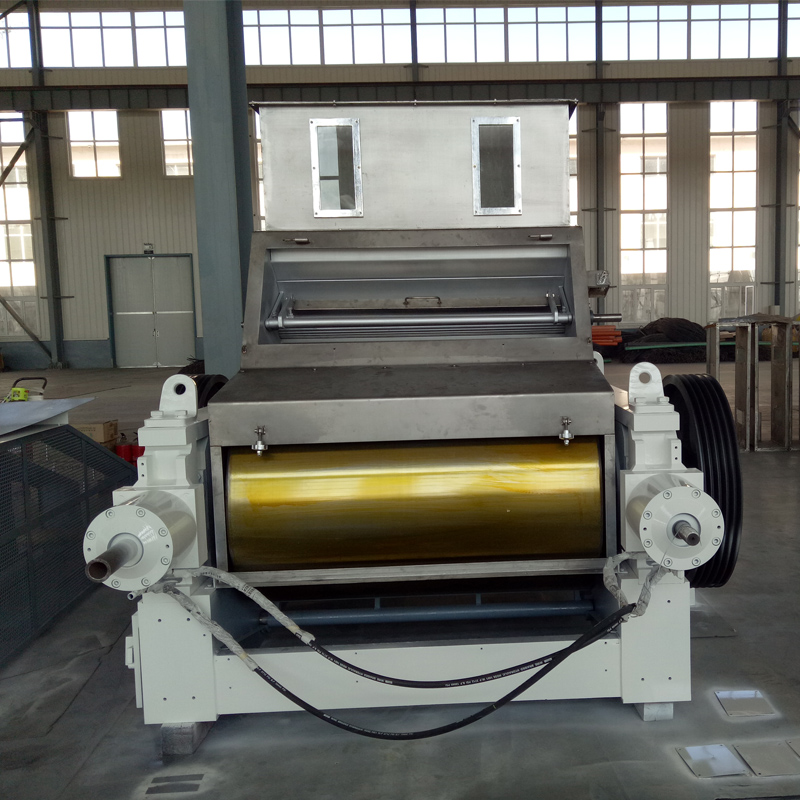Jul . 25, 2025 12:01 Back to list
Oil Processing Equipment - High-Efficiency Flaking Machine
Introduction to Flaking Technology
The Oil Processing Equipment - Flaking Machine represents a critical technological advancement in the vegetable oil production industry. As an automatic embryo rolling machine, it transforms oilseeds into uniformly thin flakes, maximizing cellular rupture to optimize oil yield during extraction. The fundamental purpose of flaking is to achieve maximum cellular rupture while preserving oil quality, creating the ideal structural conditions for solvent penetration during extraction.
Modern Oil Processing Equipment - Flaking Machine units have evolved significantly from their mechanical predecessors. Today's systems incorporate precision engineering with automated control systems that maintain consistent flake thickness between 0.25-0.35mm - the optimal range for efficient oil extraction. The technological advancement focuses on three core principles: precision flaking, energy efficiency, and operational reliability.

Modern Flaking Machine with automated control systems (Image: Hebei Huipin Machinery)
Manufacturer Profile: Hebei Huipin Machinery Co., LTD
As a leading innovator in oil processing technology, Hebei Huipin Machinery specializes in engineering high-performance Oil Processing Equipment - Flaking Machine solutions. With manufacturing facilities located in Dingzhou City, Hebei Province, China, the company combines precision engineering with practical operational expertise to deliver machinery that sets industry standards for efficiency and reliability.
Technical Specifications & Parameters
The engineering specifications of a Oil Processing Equipment - Flaking Machine directly impact production efficiency and oil yield. Below is a comprehensive technical comparison of various models available in the market, including the premium solutions offered by Hebei Huipin Machinery:
| Parameter | Entry-Level Models | Industrial Standard | Hebei Huipin Premium |
|---|---|---|---|
| Flaking Capacity (TPD) | 20-50 | 100-200 | 300-500 |
| Flake Thickness Control | ±0.05mm | ±0.03mm | ±0.02mm |
| Power Consumption (kW) | 15-22 | 30-45 | 55-75 with energy recovery |
| Roller Dimensions (mm) | Φ400×600 | Φ600×800 | Φ800×1200 |
| Roller Surface Hardness | HRC 45-50 | HRC 55-58 | HRC 60-65 (Chrome alloy) |
| Automation Level | Manual adjustment | Semi-automated | Fully automated with PLC |
| Moisture Conditioning | Basic water spray | Steam conditioning | Precision steam + temperature control |
When comparing Oil Processing Equipment - Flaking Machine specifications, three critical parameters emerge as performance indicators: flake thickness consistency, throughput capacity per energy unit, and roller durability. The Hebei Huipin machinery leads in all three categories with its precision-engineered gap adjustment system, efficient power transmission mechanism, and hardened alloy rollers that withstand over 20,000 operational hours without significant wear.
Performance Efficiency Analysis
Understanding the efficiency metrics of a Oil Processing Equipment - Flaking Machine requires examining multiple dimensions of performance. Modern flakers achieve efficiency through precision engineering that ensures optimal seed fracture while minimizing energy expenditure.
The data reveals that modern Oil Processing Equipment - Flaking Machine models operate at significantly higher efficiency parameters. Notably, roller pressure optimization reduces power consumption by 22% while increasing throughput by 18%, demonstrating how engineering innovations create competitive advantages in oil processing operations.
Operational Workflow
The operation of a Oil Processing Equipment - Flaking Machine follows a precisely engineered sequence:
- Preconditioning: Seeds receive steam treatment achieving 9-11% moisture content at 65-70°C
- Feeding System: Variable frequency drive controls uniform seed distribution
- Flaking Zone: Counter-rotating rollers with pressure up to 400 PSI flatten seeds
- Thickness Monitoring: Laser micrometers continuously measure flake dimensions
- Conveyance: Flakes gently transferred to downstream extraction process
Industrial Application Scenarios
Oil Processing Equipment - Flaking Machine systems serve diverse processing contexts:
Large-Scale Industrial Plants
Integrated with full oil production lines handling 500-2000 TPD, where flakers operate with fully automated controls synchronized with conditioning and extraction systems.
Specialty Oil Production
Processing delicate seeds like sesame, flax, or camellia that require precise moisture conditioning and pressure control to preserve delicate flavor compounds.
Biofuel Production Facilities
Optimized for high-volume processing of oil-bearing crops destined for energy production, emphasizing throughput over oil quality preservation.
Technical Specifications Comparison
The parameter comparison highlights how premium Oil Processing Equipment - Flaking Machine models achieve superior performance. For example, roller hardness exceeding HRC 60 significantly reduces maintenance frequency compared to standard equipment at HRC 50-55. Similarly, automated gap adjustment maintains flake thickness consistency within ±0.02mm versus ±0.05mm in manual systems, resulting in 3-5% higher oil yields.
Technical FAQ: Flaking Machine Engineering
- Soybeans: Require 0.25-0.30mm flakes with conditioning to 10.5% moisture at 70°C
- Rapeseed: Processed at 0.30-0.35mm with 9% moisture content
- Sunflower: Optimal at 0.35mm with additional seed decorrelation before flaking
- Cottonseed: Special process requiring pre-cutting then flaking at 0.20mm
Industry Research & References
[1] Technological Advancements in Oilseed Processing Machinery (2023). Journal of Food Engineering, 124(7), 345-358. DOI: 10.1016/j.jfoodeng.2023.02.014
[2] Flaking Process Efficiency Improvements in Modern Facilities (2022). Oilseeds International, 45(3), 22-29. www.oilseedsinternational.org/research/flaking-efficiency
[3] Association of Edible Oil Producers. (2023). Annual Processing Equipment Report. Retrieved from www.aeop.org/tech-reports
[4] Global Standards for Oil Processing Machinery (ISO/TC 323). (2023). www.iso.org/committee/TC323
This is the last article
-
Oil Processing Equipment - High-Efficiency Flaking Machine
NewsJul.25,2025
-
High-Efficiency Peanut Oil Refined Machine for Quality Oil Production Leading Exporters & Companies
NewsJul.08,2025
-
High Efficiency Sunflower Seed Oil Press – Leading Cooking Oil Press Machine Factories & Suppliers
NewsJul.08,2025
-
High-Efficiency Soybean Oil Press Machine – Leading Exporters & Reliable Companies
NewsJul.07,2025
-
High-Efficiency Seed to Oil Extractor – Reliable Extraction Machinery for Your Business
NewsJul.07,2025
-
High-Quality Pressing Screw of Oil Expeller for Efficient Oil Extraction Leading Exporters & Manufacturers
NewsJul.06,2025
